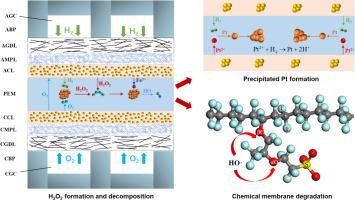A comprehensive mathematical model for chemical membrane degradation of proton exchange membrane fuel cell with considering precipitated Pt formation
IF 11
1区 工程技术
Q1 ENERGY & FUELS
引用次数: 0
Abstract
Chemical membrane degradation under open-circuit/idling condition results in membrane thinning and gas separation deterioration, which subsequently reduces the durability and lifetime of proton exchange membrane fuel cells (PEMFCs). Traditional membrane degradation models do not consider the existence of precipitated Pt in the membrane. This is the reason why the simulated membrane degradation adjacent to the anode catalyst layer (CL) is more severe than that adjacent to the cathode CL, which is not consistent with the experiment results. To address such an inconsistency, a comprehensive membrane degradation model was developed with consideration of precipitated Pt. In this model, the processes of precipitated Pt formation, H2O2 formation and decomposition, and attack of free radicals on membrane are included. This makes the simulated spatial nonuniformity of membrane degradation notably consistent with the experimental results, which subverts the traditional membrane degradation models. The concentration distributions of O2, H2, H2O2, Fe2+/Fe3+, as well as local potential and ionomer species in the membrane were obtained. Moreover, membrane degradation under various temperatures and relative humidity values was explored. It was found that an increasing temperature weakens the nonuniformity of membrane degradation and that a lowering humidity can inhibit membrane degradation. Finally, the membrane degradation process can be separated into the finite dissociation and fragmented stages, which are dominated by the scission and unzipping of ionomer chains and falling off of short-chain fragments, respectively. This model enables comprehensive understanding of the membrane degradation process and facilitates the development of corresponding mitigation strategies.

考虑沉淀Pt形成的质子交换膜燃料电池化学膜降解综合数学模型
在开路/空转状态下,化学膜降解会导致膜变薄和气体分离恶化,从而降低质子交换膜燃料电池(pemfc)的耐久性和寿命。传统的膜降解模型没有考虑膜中沉淀Pt的存在。这就是为什么阳极催化剂层(CL)附近的模拟膜降解比阴极催化剂层(CL)附近的模拟膜降解更严重的原因,这与实验结果不一致。为了解决这种不一致,我们建立了一个考虑沉淀Pt的综合膜降解模型。在该模型中,沉淀Pt的形成、H2O2的形成和分解以及自由基对膜的攻击过程都包括在内。这使得模拟膜降解的空间非均匀性与实验结果显著一致,颠覆了传统的膜降解模型。得到了膜内O2、H2、H2O2、Fe2+/Fe3+的浓度分布,以及膜内的局部电位和离子种类。此外,研究了不同温度和相对湿度下膜的降解情况。研究发现,温度升高可减弱膜降解的不均匀性,湿度降低可抑制膜降解。最后,膜降解过程可分为有限解离和碎片化两个阶段,分别以离子链的断裂和解压缩以及短链片段的脱落为主。该模型能够全面了解膜降解过程,并有助于制定相应的缓解策略。
本文章由计算机程序翻译,如有差异,请以英文原文为准。
求助全文
约1分钟内获得全文
求助全文
来源期刊

Applied Energy
工程技术-工程:化工
CiteScore
21.20
自引率
10.70%
发文量
1830
审稿时长
41 days
期刊介绍:
Applied Energy serves as a platform for sharing innovations, research, development, and demonstrations in energy conversion, conservation, and sustainable energy systems. The journal covers topics such as optimal energy resource use, environmental pollutant mitigation, and energy process analysis. It welcomes original papers, review articles, technical notes, and letters to the editor. Authors are encouraged to submit manuscripts that bridge the gap between research, development, and implementation. The journal addresses a wide spectrum of topics, including fossil and renewable energy technologies, energy economics, and environmental impacts. Applied Energy also explores modeling and forecasting, conservation strategies, and the social and economic implications of energy policies, including climate change mitigation. It is complemented by the open-access journal Advances in Applied Energy.
 求助内容:
求助内容: 应助结果提醒方式:
应助结果提醒方式:


